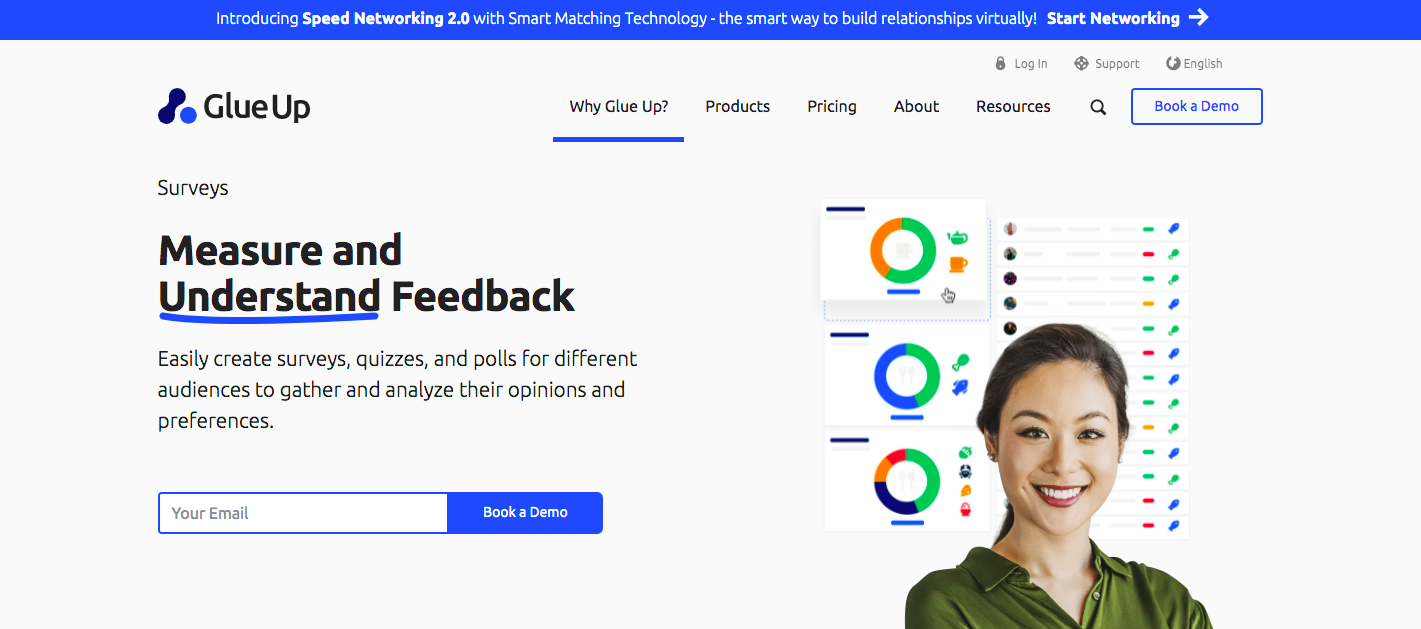![Webcast vs Webinar: Similarities and Differences [with Examples] and What's the Right Choice for You? Webcast vs Webinar: Similarities and Differences [with Examples] and What's the Right Choice for You?](/sites/default/files/image_1734.png)
Nowadays, many people talk about webcast vs webinar due to the sudden rise of virtual events and live streaming platforms. However, there are still a series of questions about the similarities and differences in structure and function between the two.
In this article, we will explain what they are and help you determine which platform is the best to use to gain the exposure you are looking for.
Quick Reads
- What Is a Webcast?
- What Is a Webinar?
- Webinar Vs. Webcast: The Differences
- Webinar Vs. Webcast: The Similarities
- Webcast Vs Webinar: Pros and Cons
- Should I Host a Webinar or Webcast?
- How to Host a Webinar or Webcast?
What Is a Webcast?
Online events represent a wide industry, and webcasts are a big part of it. To put it simply, a webcast is a new technology that allows you to do a video stream of an event or conference. It’s basically a web and a broadcast combined, which can be streamed live or on demand. Webcast most of the time is the online broadcasting of a live event.

Characteristics of a Webcast
The main characteristic of a webcast is that it’s designed for a large number of people since it’s an event that’s being recorded and streamed. The best feature of a webcast is that no one will ever miss your event ever again. Attendees will be able to follow through their PC or mobile devices. Moreover, the event can be streamed by thousands of people at once.
Another important feature of the webcast is that they are usually a ‘’one-way flow''. Meaning, the host will usually present video content and slides to the audience.
However, there isn’t any interaction between the host and the attendees or even between the attendees. Usually, webcasts are also streamed ‘’live’’ on big social media platforms like Facebook or YouTube.
Webcast Types
There are two main types of webcasting solutions: the presentation-based webcast and the media-based webcast.
The presentation-based webcast is a type of broadcast format where the host simply broadcasts videos, PowerPoint slides, and Excel content to the audience with no engagement from them. You can also clearly see the presentation in a larger window.
On the other hand, the media-based webcast is a type of webcast function that allows you to have much more flexibility in broadcasting your event since there’s no time limit. However, since it lets you send full-motion videos to your attendees, it requires more equipment like high-quality cameras and creative graphics.
Furthermore, it’s more expensive than the presentation-based one. It’s usually used to stream live events such as concerts or church services.
When to Use a Webcast
It’s important to know all webcast functions and features to understand when it’s better to use them. You might use a webcast for events that cannot be attended live and needs to be broadcasted. TED talks and music festivals can be streamed online to a broader audience after the event has ended. This means that webcasts are cost-efficient and convenient for events that are exclusive but inaccessible.
What Is a Webinar?
A webinar, on the other hand, is a platform that allows you to connect with your audience online and in real-time. It’s composed of a host that usually presents to a group of attendees that participate in the event from different places and locations. They can interact with each other via chat using microphones and cameras.

Characteristics of a Webinar
First of all, they are designed not only for a small group of people, but also for up to hundreds of attendees. The audience can join the meeting live from any location in the world, connecting in real-time with many people at once. On top of that, the real key feature of webinars is of course the ability to interact and engage with attendees.
This function brings up the essence of a real in-person meeting since it allows everyone to share their opinion and feedback just like in a real event. Features like Q&A, polls, and the chat are useful to keep the audience engaged and entertained, creating a fun and effective meeting.

If you want to easily create online polls, be sure to check out Glue Up’s Surveys Solution. It lets you easily create surveys, quizzes, and polls for different audiences to better analyze their preferences and opinions.
What’s more, webinars have the ability to fully record sessions or meetings. This allows people who couldn’t attend it to watch it later at their own time and eventually ask further questions by email.
Webinar Types
If you are new to virtual events and interested in knowing the different types of webinars you can host, below are some great ideas you can follow as you prepare for the next webinar event.
- eLearning webinars. These kinds of webinars are the most common in the online events industry. As the name says, they are usually used to cover and discuss educational content that everyone can attend.
- Training Webinars. Companies are using webinars to train their employees since it’s the easiest way to connect. A training webinar consists of a lecture or a lesson delivered to the audience to give knowledge on updates or new functions.
- Product demonstration webinars . Whenever you are launching a new product, and you want to promote it, these webinars are perfect for you. They tend to be more engaging so that you can get feedback straight away from your audience. At the same time, you can make a good impression when you engage attendees and answer their questions about new products.
Now that you’re familiar with the popular webinar types you can host, keep in mind that they can be a great tool to establish your business and add value to the knowledge you share.
When to Use a Webinar
The main function of webinars is the live factor, which allows you to connect with many people at once while on a live stream. For example, you can use them for a company meeting to explain a new function of the software. Also, you can present a new product to an audience and get fee their feedback right away using this platform.
Take advantage of the ‘’live’’ factor as much as possible by asking questions, involving attendees, and exchanging opinions, just like in a face-to-face meeting.
Webinar Vs. Webcast: The Differences
It may look like there isn’t a big difference between webcasts and webinars. However, being able to differentiate them is essential to explore the world of tech communication. Below you will find the differences between the two and learn which is more suitable depending on the event you will be launching.

Differences in Features
The main difference between webinars and webcasts would be their technological system. Webinars are designed to be more interactive among attendees and also with the host.
For this reason, a webinar requires technological equipment such as good webcams and microphones. The chat feature, the screen-sharing, and the ability to share documents are the main features that differentiate a webinar.
When talking about webcasts, the main difference is that they don’t have features that could possibly allow any interactions. Chat, Q&As, and PowerPoint presentations don’t exist, so consequently, this doesn’t leave room for interaction of any kind.
Differences in Implementation
The contexts in which both webinars and webcasts are used are totally different. The most important thing in webinars would be to provide relevant content and increase interaction with the attendees. Live streaming webcasts ‘’flow in only one way’’ meaning that the main focus is on the presentation itself and on passively learning what is being presented.
Differences in Audience Size and Make-Up
Generally, all virtual meetings allow more people to participate in the event more easily. However, there are some differences to point out.
In webinars, considering their interactive functions, it would be quasi-impossible to host a meeting with thousands of people and make them interact with each other. Indeed, webinars are ideal for discussion between a small or a medium group of people.
On the other hand, since webcasts don’t require interaction, they can be streamed by a larger public than webinars.
Differences in Engagement and Interaction Levels
As previously said, engagement is probably the biggest difference between webcasts and webinars. Webinars allow you to interact with many functions: pools, Q&As, and surveys. You can also share documents and share your screen for attendees to see what you are presenting.
On the contrary, webcasts are totally different since attendees can only listen to the virtual event passively and not interact in any way. However, the absence of interaction allows the webcast to target a bigger audience than the webinar.
Differences in Timings
Webcasts are effective in delivering content and information to a big audience compared to a webinar. Also, you do not stream them live, so attendees can always watch them at any time. This can lead to a more successful online event.
On the other hand, webinars are hosted ‘’live’’ so they are time-bounded, and consequently, they have a smaller audience. However, they are more engaging, and people enjoy them more because they can interact and not listen passively. You can record webinars as well so that attendees can re-watch them once it’s finished.
Webinar Vs. Webcast: The Similarities
Understanding webinars and webcasts might be confusing sometimes. Keep in mind, however, that they are similar in function and execution in some ways. Here you will find the key similarities to note.
The Type of Broadcast
There are some similarities in terms of broadcasting. Talking about webinars, they usually accommodate a small or a medium audience in the platform that generally follows the event in various places. A webcast as well can be broadcasted for a medium audience, becoming few-to-many.
The Function
The function of a webinar isn’t that rigid. It’s not always used for events where participants speak and interact with each other. Sometimes webinars can also be used to present a product or to teach a new update to company members.
Here is the point where webinars and webcasts collide. Webcasts as well can be used and streamed to present and demonstrate something. For instance, you can use them to discuss a product launch, a video game commentary, or a book review.
Both virtual meetings are useful for presenting and explaining a product or a concept. The only difference is that the webinar requires interactivity and the webcast doesn’t.
The Audience
As previously said in the above section, Webcasts could potentially cover a bigger audience compared to a regular webinar. Indeed, too many attendees in a webinar could defeat the event's primary goal, which is to allow interaction between the attendee.
However, there are some corporate webinars or big webinar events that can host a bigger audience than normal. It all depends on the nature of the event. Therefore, the number of attendees should equal the topic of the event.
Everyone is free to watch it without any time restriction in webcasts, so the webcasts typically have a bigger audience.
The Collaboration
The last common point between webinars and webcasts is the ability to collaborate. During a webcast, the virtual meeting host can work together with other webcasters and stream together. There are many ways to insert videos and other multimedia content in the webcast and be able to interact.
Webinars, on the other hand, are already interactive but can increase participation by letting attendees be speakers. They can directly speak with the other attendees and the host, involving everyone.
The conclusion is that both webinars and webcasts are web broadcast services, and of course, they have their differences and similarities. They share the same purpose, which is to engage the audience and deliver the content.
However, they differ in the way the content is delivered. Webinars are best for small to medium-sized audiences with whom you can interact, while webcasts are best suited for big-sized audiences but offer no interactivity with/among them
Webcast Vs Webinar: Pros and Cons
Virtual meetings can have their problems and advantages. Here, you can look at the pros and cons of webinars and webcasts to run your event smoothly and avoid mistakes.
The pros of hosting a Webinar would be about having an interactive event with the attendees, having more control over the meeting, having many tools to communicate, and flexibility. On the other hand, the cons are that the number of people is limited, and the length of the webinar is limited as well.
On the other hand, the pros of webcasts would be that they can be watched anywhere and anytime, they are extremely accessible and all you need is a stable internet connection to access them.
The cons would be the lack of interaction among attendees either by virtual meetings or online messaging/chat, and because of that, they are less flexible.
Should I Host a Webinar or Webcast?
Every type of virtual event has its own characteristic and functions. You just need to know which one to use to make your event stand out.
If you are looking to host an event where you want attendees to participate directly, give feedback, and interact with others, you should absolutely go for a webinar. The choice of a live webinar will help you engage more with your audience in a ‘’live’’ event and deliver a presentation to multiple people in different locations.
However, if you are looking for a more flexible event that requires less intervention from the attendees, webcasts are the best option. They don’t require a fixed time to watch them, since anyone can choose to watch it at their own time.
The downside is that they don’t allow much interaction. So if you are looking to create an informational video, consider using a webcast since it doesn’t require direct involvement.
How to Host a Webinar or Webcast?
Webinars and webcasts are tools from which an organization or a company can benefit. They are indispensable to connect with people and to communicate information in real-time. Despite their differences and their purposes, both webinars and webcasts are essential in helping your business grow and communicate with people efficiently.
Use Glue Up Webinar or Webcast Platform
Planning or arranging events can be challenging, but you can make it much easier when you integrate it with a digital platform solution. If you want to launch successful webinars and webcasts using a great, faster, and efficient platform, book a demo of Glue Up’s Webinar Management Software now. Give your attendees a premium experience by providing them access to presentations, agendas, as well as the ability to connect and chat with each other during live events.



